Students must start practicing the questions from CBSE Sample Papers for Class 10 Science with Solutions Set 11 are designed as per the revised syllabus.
CBSE Sample Papers for Class 10 Science Set 11 with Solutions
Time: 3 Hours
Maximum Marks: 80
Instructions
- This question paper consists of 39 questions in 5 sections.
- All questions are compulsory. However, an internal choice is provided in some questions. A student is expected to attempt only one of these questions.
- Section A consists of 20 objective-type questions carrying 1 mark each.
- Section B consists of 6 Very Short questions carrying 2 marks each. Answers to these questions should be in the range of 30 to 50 words.
- Section C consists of 7 Short Answer type questions carrying 3 marks each. Answers to these questions should be in the range of 50 to 80 words.
- Section D consists of 3 Long Answer type questions carrying 5 marks each. Answers to these questions should be in the range of 80 to 120 words.
- Section E consists of 3 source-based/case-based units of assessment of 4 marks each with sub-parts.
Section A
Select and write the most appropriate option out of the four options given for each of the questions 1-20.
Question 1.
Consider the given flowchart.
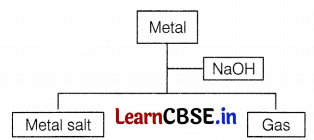
Which of the following two combinations are correct?
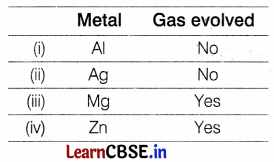
(a) (i) and (iii)
(b) (ii) and (iii)
(c) (ii) and (iv)
(d) (i) and (iv)
Answer:
(c) (ii) and (iv)
The correct combination is (ii) and (iv) as [1]
(i) When Al reacts with NaOH, the salt of aluminium is formed with the evolution of hydrogen gas.
2Al (s) + 6NaOH (aq) → 2Na
3
AlO
3
+ 3H
2
↑
(ii) When silver and sodium hydroxide react together, no reaction occurs. Hence no evolution of gas occurs.
(iii) Magnesium and sodium hydroxide do not react with each other. Hence, no evolution of gas.
(iv) When zinc reacts with sodium hydroxide, zinc salt is formed by the evolution of hydrogen gas.
Zn (s) + 2NaOH (aq) → Na
2
ZnO
2
+ H
2
↑
Question 2.
Dominant alleles are expressed exclusively in a heterozygote, while recessive traits are expressed only if the organism is ……………… for the recessive allele.
(a) Homozygous
(b) Heterozygous
(c) Normal
(d) None of these
Answer:
(a) Homozygous
Explanation: According to Mendel’s law of dominance, when there is a heterozygote (an organism with two different alleles for a trait), one allele will dominate and mask the presence of the other allele. Only the dominant allele will be expressed and contribute to the physical characteristics (phenotype). The recessive allele remains hidden but can still be passed on to offspring in the same way as the dominant allele. The recessive trait will only be visible in offspring who inherit two copies of this recessive allele.
![]()
Question 3.
__________ can be used as an acid-base indicator by a visually impaired student.
(a) Litmus
(b) Vanilla essence
(c) Turmeric
(d) Petunia leaves
Answer:
(b) Vanilla essence
Vanilla essence is an olfactory indicator. So, its smell is different in acidic and basic media which can be detected easily by a visually impaired student. It has a characteristic pleasant smell. If a basic solution like sodium hydroxide solution is added to it, an acidic solution like hydrochloric acid, however, does not destroy the smell of Vanilla extract.
Question 4.
Which of the following salts does not contain water of crystallization?
(a) Blue vitriol
(b) Baking soda
(c) Washing soda
(d) Gypsum
Answer:
(b) Baking soda
Explanation:
Baking soda: It is sodium bicarbonate (NaHCO
3
) in anhydrous form without any water of crystallisation.
Blue Vitriol: It is hydrated salt of copper sulphate containing 5 molecules of water of crystallisation (CuSO 4 . 5H 2 O).
Washing soda: It is hydrated salt of sodium carbonate containing 10 molecules of water of crystallisation (Na 2 CO 3 .10H 2 O)
Gypsum: It is hydrated salt of calcium sulphate containing 2 molecules of water of crystallisation (CaSO 4.2 H 2 O
Question 5.
The reaction between potassium bromide and silver nitrate is an example of
(a) combination reaction
(b) decomposition reaction
(c) double displacement reaction
(d) displacement reaction
Answer:
(c) double displacement reaction
The reaction between potassium bromide and silver nitrate forms two products: silver bromide and potassium nitrate.

This reaction is an example of a double displacement reaction as Ag and K are displaced by each other.
Question 6.
A farmer wants to grow banana plants genetically similar enough to the plants already available in his field. Which one of the following methods would you suggest for this purpose?
(a) Regeneration
(b) Budding
(c) Vegetative propagation
(d) Sexual reproduction
Answer:
(c) Vegetative propagation
Explanation: Vegetative propagation is a method of plant reproduction that involves using vegetative parts of a plant, such as stems, roots, or leaves, to create new individuals that are genetically identical to the parent plant. This method ensures that the desired characteristics of the parent plant, including fruit quality and traits, are preserved in the new plants. This method avoids the genetic variation that can occur through sexual reproduction, which involves the combination of genetic material from two different parent plants and may result in offspring with different traits.
![]()
Question 7.

In the above-given reaction, alkaline KMnO
4
acts as
(a) reducing agent
(b) oxidizing agent
(c) catalyst
(d) dehydrating agent
Answer:
(b) oxidizing agent
KMnO
4
acts as an oxidizing agent because it removes hydrogen from CH
3
CH
2
OH and adds one oxygen to it.
Question 8.
Characters transmitted from parents to offspring are present in:
(a) Cytoplasm
(b) ribosome
(c) Golgi bodies
(d) genes
Answer:
(d) genes
Explanation: Characters are transmitted from parents to offspring through genes. Genes are the heredity units of the body in living organisms. Chromosomes in the nucleus of a cell contain information for the inheritance of features from parents in the form of DNA (Deoxyribonucleic acid). This DNA contains genes.
Question 9.
The graph shows, how the amount of carbon dioxide taken by a plant.
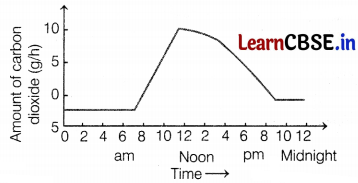
Why is the uptake of CO
2
higher during day time?
(a) due to the large number of structures in the daytime
(b) due to photosynthesis
(c) due to transpiration
(d) due to more water absorption
Answer:
(b) due to photosynthesis
Plants take in CO
2
from the atmosphere for preparing food. At night or early morning, photosynthesis does not occur hence, they take in oxygen and give out CO
2
.
Question 10.
Which of the following statements is not true about Thyroxine?
(a) Thyroxine regulates the basal metabolism of our body.
(b) Iodine is an important component required for the synthesis of Thyroxine.
(c) Under secretion of Thyroxine causes simple goiter.
(d) Iron is essential for the synthesis of Thyroxine.
Answer:
(d) Iron is essential for the synthesis of Thyroxine.
Explanation: Iodine, not iron, is required to synthesize Thyroxine. It controls the glucose, protein, and fat metabolism of the body. The thyroid gland produces Thyroxine, which is also known as thyroid hormone.
Question 11.
Which part of the human brain controls body temperature?
(a) Pituitary
(b) Diencephalon
(c) Hypothalamus
(d) None of the above
Answer:
(c) Hypothalamus
The hypothalamus controls and regulates the temperature of the body, the urge to eat, drink, sleep, etc.
![]()
Question 12.
In which direction do afferent neurons carry nerve impulses?
(a) From the central nervous system (CNS) to muscles
(b) From the CNS to receptors
(c) From receptors to the CNS
(d) From effector organs to the CNS
Ans.
(c) From receptors to the CNS
Explanation: Afferent neurons, also known as sensory neurons, are responsible for transmitting nerve impulses from sensory receptors in the peripheral nervous system to the central nervous system (CNS). These neurons carry sensory information, such as touch, temperature, pain, and other stimuli, from various parts of the body to the CNS for processing and interpretation.
Question 13.
Four students set up the circuit for the experiment of Ohm’s law as shown. Which of the following options is correct?
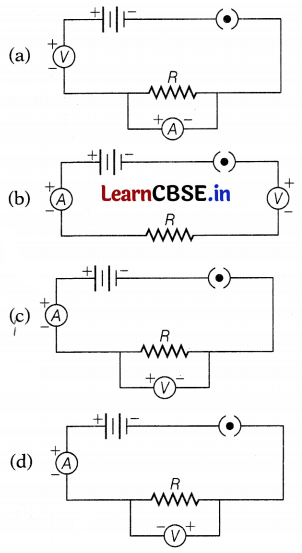
Answer:
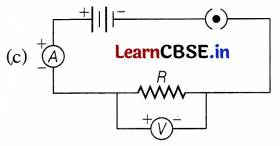
In the circuit, the ammeter should always be connected in series and the voltmeter should always be connected in parallel combination. Hence, the correct circuit set-up is shown below.
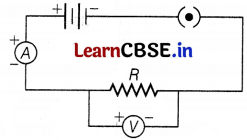
Question 14.
A current flows in a wire, running between the S and N poles of a magnet lying horizontally, as shown inithe figure below:

The force on the wire due to the magnet is directed.
(a) From N to S (c)
(b) From S to N (d)
(c) Vertically downwards
(d) Vertically upwards
Answer:
(c) Vertically downwards
Explanation: Force on the conductor is calculated using Fleming’s left-hand rule.
Question 15.
A food web is the
(a) food that a spider collects using its web
(b) network of interlinked trophic levels
(c) network of interlinked food chains
(d) display of food items on a website
Answer:
(c) network of interlinked food chains
A food web is a network of interlinked food chains operating at various trophic levels.
![]()
Question 16.
Mutual induction is a process in which current is induced in the neighboring coil if current flows in a coil. In the figure shown below:

(a) Maximum in the situation (A)
(b) Maximum in situation (B)
(c) Maximum in the situation (C)
(d) Same in all situations
Answer:
(a) Maximum in situation (A)
Explanation: As both the coils are in the same plane the induced current is found to be highest when 1 the direction of the coil is at the right angle to the magnetic field.
Directions (Q.Nos. 17-20) consist of two statements – Assertion (A) and Reason (R). Answer these questions by selecting the appropriate option given below.
(a) Both A and R are true and R is the correct explanation of A.
(b) Both A and R are true, but R is not the correct explanation of A.
(c) A is true, but R is false.
(d) A is false, but R is true.
Question 17.
Assertion (A): Diamond does not conduct electricity.
Reason (R): Diamond has a high refractive index.
Answer:
(b) Both A and R are true but R is not the correct explanation of A.
The correct reason is, that due to the absence of free electrons, diamond does not conduct electricity.
Question 18.
Assertion: Electric current flowing through a metallic wire is directly proportional to the potential difference across its ends.
Reason: Ohm’s law expression V = IR, where R (resistance) of the wire is always varying.
Answer:
(c) A is true, but R is false.
Explanation: Ohm’s law states that the electric current flowing through a metallic wire is directly proportional to the potential difference across its two ends. The expression is written as :
V = IR
Here, R (resistance of the wire) is a constant value, so only the statement will be valid.
V ∝ I only if \(\frac{V}{I}\) = constant
Question 19.
Assertion (A): DNA copying is necessary during reproduction.
Reason (R): DNA copying leads to the transmission of characters from parents to offspring.
Answer:
(a) Both A and R are true and R is the correct explanation of A.
DNA copying is necessary during reproduction because it leads to the transmission of characters from parents to offspring and brings about variation.
Question 20.
Assertion: Hydrogen peroxide is kept in coloured bottles.
Reason: Hydrogen peroxide is a moderately reactive metal that can react with light or heat slowly to produce water.
Answer:
(c) A is true but R is false
Explanation: Hydrogen peroxide is a highly reactive metal that can react with light or heat to produce water. It decomposes into water and oxygen in the presence of sunlight. To prevent this reaction with light and heat it is stored in coloured bottles so that light cannot pass through it.
Section B
Questions No. 21 to 26 are Very Short Answer Questions.
Question 21.
What is a covalent bond? What type of bond exists in CCl
4
and CaCl
2
?
Answer:
The chemical bonds formed between two atoms by the sharing of electrons between them is known as a covalent bond. (1)
- CCl 4 – Covalent bond
- CaCl 2 – Ionic bond (1)
Question 22.
Answer the following questions:
(i) Define the power of a lens.
(ii) Name the lens that has:
(a) Negative power.
(b) Positive power.
Answer:
(i) The ability of a lens to converge the rays of light falling on it is called the power of the lens,
(ii) (a) The focal length of a concave lens is negative, so its power is negative.
(b) The focal length of a convex lens is positive, so its power is positive.
![]()
Question 23.
Goitre is caused by which endocrine gland? Write one primary prevention.
Or
Explain the functions of a neuron.
Answer:
Goitre is caused by the deficiency of thyroxine hormone secreted by the thyroid gland. Uptaking an optimum amount of iodine helps in preventing this disease. In hilly areas, iodine is deficient in water which causes goitre disease in most of the population in that area. Iodized salt uptake can help in the prevention of this disease. (2)
Or
Functions of a neuron The neuron receives information from receptors as electrical impulses, at its dendritic end. The impulse then travels from the dendrite to the cell body and further along the axon to its end. At the end of the axon, an electrical impulse leads to the release of some chemicals. These chemicals cross the synapse and reach the next neuron. This is how nerve impulses travel through the body. Thus, neurons are important in receiving information from the surroundings and in sending it to the effector. (2)
Question 24.
The diagram shows one layer of carbon atoms in graphite.

(i) Identify the type of bonding in graphite.
(ii) Which property of graphite makes it suitable for use as a dry lubricant? Explain.
Answer:
(i) Between the carbon atoms in each layer covalent bond is found and Van Der Waal’s forces are found between the layers of carbon atoms in graphite.
.phrase:
Question 25.
What are magnetic field lines? Justify the following statements.
(a) Two magnetic field lines never intersect each other.
(b) Magnetic field lines are closed curves.
Or
You have two electric lamps having ratings 40 W, 220 V and 60 W, 220 V. Which of the two has a higher resistance? Give a reason for your answer. If these two lamps are connected to a source of 220 V, which will glow brighter?
Answer:
The imaginary lines representing the magnetic field around a magnet are known as magnetic field lines.
(a) If two field lines intersect each other, this would mean that at the point of intersection, the direction of the magnetic field is in two directions, which is not possible. (1)
(b) The direction of field lines outside a magnet is from the North pole to the South pole while it is from the South to the North pole inside the magnet and thus forms closed curves. (1)
Or
We know that, power, P = \(\frac{V^2}{R}\)
Thus, resistance is inversely proportional to power, i.e., higher power less will be resistance and vice-versa. So, the electric lamp with a power rating of 40 W will have a higher resistance as compared to a 60 W lamp. Lamps with higher power will glow brighter. Hence, a lamp with 60 W power will glow brighter.
![]()
Question 26.
State the various characteristics of chemical reactions.
Answer:
Some of the characteristics of chemical reactions are:
- Formation of a precipitate
- Change in colour
- Change in temperature
- Change in the state.
- Evolution of a gas
Section C
Questions No. 27 to 33 are Short Answer Questions.
Question 27.
Explain the reactions of different metals with hot water, cold water, and steam. Give one example with a properly balanced chemical equation. Name of the two metals which do not react with any form of water.
Or
How is the method of extraction of metals high up in the reactivity series different from that for metals in the middle? Why can be same process not be applied for them? Name the process used for the extraction of these metals.
Answer:
Reaction of metal with water
(a) With cold water

(b) With hot water

(c) With steam
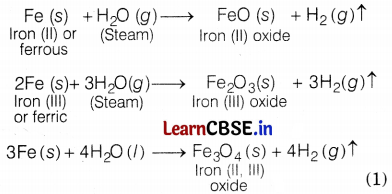
Gold and silver do not react with any form of water.
Or
The metals in the middle of the reactivity series (such as iron, zinc, lead, copper, etc.) are moderately reactive. Thus, to obtain such metals from their compounds, their sulphides and carbonates are first converted into their oxides by the process of roasting and calcination respectively and then the metal oxides are reduced to corresponding metal by using suitable reducing agents such as carbon. (2)
On the other hand, metals which are high up in the reactivity series (such as sodium, magnesium, calcium, aluminium, etc.) are very reactive and cannot be obtained from their compound by heating with carbon. Therefore, such metals are obtained by electrolytic reduction of their molten salt. (1)
Question 28.
Obtain an expression for the magnification of an image formed by a concave mirror.
Answer:
Consider the formation of the image A’B’ of an object AB by a concave mirror. As shown in given

\(\frac{\mathrm{A}^{\prime} \mathrm{B}^{\prime}}{\mathrm{AB}}=\frac{\mathrm{PB}^{\prime}}{\mathrm{PB}}\)
As per sign convention followed, PB = – u, PB’ = – υ, AB = size of the object = + h and A’B’ = size of the
image – h’.
Hence, we have
\(\frac{-h^{\prime}}{h}=\frac{-v}{-u}\)
or \(\frac{h^{\prime}}{h}=\frac{-v}{u}\)
Thus, by definition of magnification of the image, we have
Magnification, m = \(\frac{h^{\prime}}{h}=-\frac{v}{u}\).
Question 29.
Explain how voluntary actions and reflex actions are different from each other.
Answer:
The difference between involuntary actions and reflex actions are as follows:
| Involuntary Actions | Reflex Actions |
| They involve the autonomic nervous system. | They involve all parts of the voluntary nervous system though they are not under our control. |
| They involve the functioning of the internal body parts. | They are concerned with emergencies. |
| The nervous system controlling involuntary actions has two divisions, sympathetic and parasympathetic. | There are no such divisions. |
| They occur in response to internal stimuli. | They commonly operate against harmful stimuli, which are generally external. |
| Most of the involuntary functions occur all the time. | Reflex actions occur occasionally. |
| Sometimes gap occurs between stimulus and response. | They are almost instant. |
| They are carried out by smooth muscles. | They are performed by striated muscles. |
| The beating of the heart and peristalsis. | Closing of eyes when light is flashed on them. |
Question 30.
How does Mendel’s experiment show that traits are inherited independently?
OR
The given box diagram represents the ratio of females to males or the sex ratio in our country for 10 decades (1901 to 2001). Answer the following questions in light of your knowledge of sex determination and the data presented in the box diagram.

(i) What does the bar diagram show?
(ii) As per scientific knowledge regarding sex determination, what should be the sex ratio or the male-to-female ratio at a given point of time?
(iii) Assign one reason for the trend showing deviation from the expected sex ratio.
(iv) Suggest a way for which such a trend can be stopped.
Answer:
Mendel’s experiment show that:
(i) When a cross was made between a tall pea plant with round seeds and a short pea plant wrinkled seeds, the F
1
progeny plants are all tall with round seeds. This indicates that tall and round seeds are the dominant traits.
(ii) When the F 1 plants are self-pollinated and the F 2 progeny show that some progencies tall with round seeds and some progenies were short plants with wrinkled seeds, which are the traits visible in the F 2 generation.
(iii) There were also some progenies with new combinations like tall plants with wrinkled seed short plants with round seeds.
OR
(i) Bar diagram shows the proportion of females in the population over a decade.
(ii) 1 : 1 should be the sex ratio or the male-to-female ratio at a given point of time.
(iii) Female foeticide is the main reason for this trend showing deviation from the expected sex ratio.
(iv) Banning sex tests of unborn babies; increasing awareness and education will help to stop such trends.
![]()
Question 31.
Two resistors with resistances 5 Ω and 10 Ω respectively, are to be connected to a battery of emf 6 V. How will you connect the resistances to obtain
(a) maximum current?
(b) Calculate the strength of the total current in the circuit in the two cases.
Answer:
(a) For obtaining maximum current, the two resistors should be connected in parallel. (1)
(b) ∴ Total current in the circuit, (parallel combination)
I = \(\frac{V}{R}=\frac{6 \times 3}{10}\) = 1.8 A
∴ Total current in the circuit, (series combination)
I = \(\frac{V}{R}=\frac{6}{15}\) = 0.4 A (2)
Question 32.
A student wants to get the image of a candle flame on the walls of a school laboratory by using a lens.
(a) Which type of lens should he use and why?
(b) At what distance in terms of focal length F of the lens should he place the candle flame, to get a magnified and diminished image respectively, on the wall?
Answer:
(a) He should use a convex lens as real images are formed by it. (1)
(b) For a magnified image, he should place the candle flame between the focus (F) and centre of curvature (2F) of the lens. To get a diminished image, he should place the candle flame beyond centre of curvature (2F) of the lens. (2)
Question 33.
Give the basic features of the mechanism of inheritance.
Answer:
The basic features of inheritance are as follows:
- Characters are controlled by genes.
- Each gene controls one character.
- There may be two or more forms of gene.
- One form may be dominant over the other.
- Genes are present on chromosomes.
- An individual has two forms of gene whether similar or dissimilar. (\(\frac{1}{2}\) × 6)
Section D
Questions No. 34 to 36 are Long Answer Questions.
Question 34.
Explain the nutrition process in Amoeba.
OR
(i) Explain the statement “Bile does not contain any enzyme but it is essential for digestion”.
(ii) Explain the process of breathing in human beings.
Answer:
Amoeba follows holozoic nutrition.
It involves the following steps:
- Ingestion – Amoeba engulfs the food by using its temporary finger-like projections called pseudopodia. This process is called ingestion.
- Digestion – The food which is taken inside the amoeba forms a food vacuole. Many enzymes are secreted into the food vacuole and the complex food molecule is converted into a simple and diffusible form.
- Absorption and assimilation – The digested food is absorbed by the cell by the diffusion process.
- Egestion – The undigested residue which remains in the vacuole is expelled.

OR
(i) Though bile juice secreted by liver has no enzymes in it is still essential for digestion because:
- It makes the medium alkaline in the small intestine so that intestinal juice can perform its functions because the food from stomach which enters the small intestine is acidic in nature.
- It emulsifies fats so that enzymes like lipase can act upon fats to convert them into fatty acids and glycerol.
(ii) Breathing process occurs by inhalation and exhalation.
1. Inhalation: It is the process by which oxygen is taken in through nostrils. During inhalation process, the ribs move upwards and outwards due to contraction of intercostal muscles. The diaphragm is lowered so that the volume of thoracic cavity increases. As a result air is forced inside the lungs through nostrils.
2. Exhalation: It is the process by which carbon dioxide is exhaled out from lungs through nostrils. During this process the ribs moves inwards and diaphragm comes back to its original position. The volume of thoracic cavity decreases so air is forced out through the lungs.

![]()
Question 35.
(a) Marriage between cousins is a taboo in most of the countries of the world except in some Asian countries. Why should marriage between close cousins be prevented and which measures will you take to prevent such practices?
(b) Describe the process of fertilization in a flower.
Or
(a) Explain the events of double circulation.
(b) Differentiate between fermentation in yeast and aerobic respiration based on the end products formed.
Answer:
(a) Marriage between close cousins should be prevented as the recessive traits with the genetic defects present in such families will become homozygous and cause harmful diseases Children should be educated about the ill effects so that they come to know about the defects in marriages among close cousins. These are the measures that can be taken to prevent such practices. (2)
(b) It is the process of fusion of male germ cells with the female gametes. It gives rise to a zygote. As soon as the pollen lands on a suitable stigma, it reaches the female germ cells in the ovary. This occurs via pollen tube. The pollen tube grows out of the pollen grain, travels through the style, and finally reaches the ovary. The fertilization In the flowering plant is shown in the given figure.
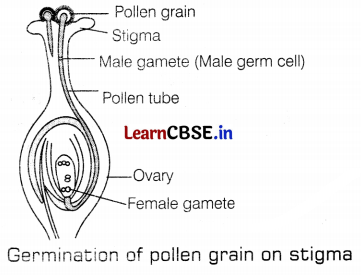
After fertilization, the zygote divides many times and forms an embryo within the ovule. This ovule then develops a tough coat and gets converted into a seed. The ovary rapidly grows and ripens as fruit. The seed contains the future embryo that develops into a seedling under suitable conditions. This process is known as germination. (3)
Or
(a) During double circulation in human beings, the blood passes twice through the heart during one complete cycle of circulation. The double circulation includes the following processes. (1)
- Pulmonary circulation: In this, the deoxygenated blood is pushed by the right ventricle to the lungs for oxygenation. The oxygenated blood then comes back to the left atrium of the heart through the pulmonary veins. (1)
- Systemic circulation: In this circulation, oxygenated blood from the left ventricle of the heart is passed to the different parts of the body through the aorta. Such a separation allows a highly efficient supply of oxygen to the body. This is useful in animals that have high energy needs such as birds and mammals including human beings, which constantly use energy to maintain their body temperature.
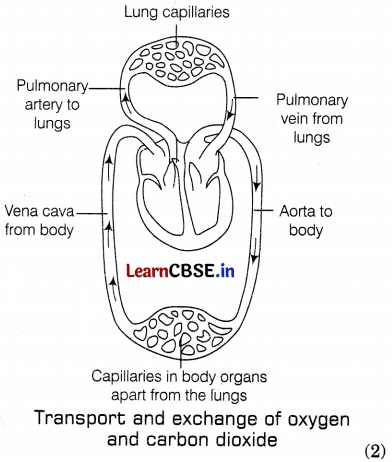
(b) During fermentation in yeast, ethanol is formed, while in aerobic respiration CO
2
and water are formed. The energy released in the process of fermentation is also much less as compared to energy released in aerobic respiration. (1)
Question 36.
(i) “A convex lens can form a magnified erect as well as magnified inverted image of an object placed in front of it.” Draw a ray diagram to justify this statement stating the position of the object concerning the lens in each case.
(ii) An object of height 4 cm is placed at 20 cm from a concave lens of focal length 10 cm. Use lens formula to determine the position of the image formed.
OR
(i) To construct a ray diagram, we use two rays which are so chosen that it is easy to know their directions after reflection from the mirror. List two such rays and state the path of these rays after reflection in case of concave mirrors. Use these two rays and draw a ray diagram to locate the image of an object placed between the pole and the focus of a concave mirror.
(ii) A concave mirror produces three times magnified image on a screen. If the object is placed 20 cm in front of the mirror, how far is the screen from the object?
Answer:
(i) Case I: Image formed is magnified and erect when the object is placed between the optical centre and focus on a convex lens.

Case II: Image formed is magnified and inverted when the object is placed between F and 2F of a convex lens.

(ii) Given: u = – 20 cm, f = – 10 cm.
Using lens formula,
\(\frac{1}{f}=\frac{1}{υ}-\frac{1}{u}\)
⇒ \(\frac{1}{υ}=\frac{1}{f}+\frac{1}{u}\)
⇒ \(\frac{1}{υ}=-\frac{1}{10}-\frac{1}{20}\)
⇒ \(\frac{1}{υ}=\frac{-2-1}{20}=\frac{-3}{20}\)
⇒ υ = \(\frac{-20}{3}\) cm
OR
(i) The following rays of light are usually used to locate the images formed by a spherical mirror : The incident ray passing through the centre of curvature: In this case, light after reflecting from the spherical mirror moves back along the same path.

The ray incident obliquely to the principal axis: In this case, the incident ray will be reflected back by the reflecting surface of the spherical mirror obliquely, making equal angles with the principal axis.

When the object is placed between the pole and the focus of the concave mirror, an image is formed behind the mirror and is virtual, erect and magnified.

(ii) Given, Magnification, m = – 3 (As the image is real), Object distance, u = – 20 cm
We have, m = –\(\frac{υ}{u}\)
⇒ – 3 = – \(\left(\frac{υ}{-20}\right)\)
⇒ υ = – 60 cm
The image is located at 60 cm in front of the mirror.
Thus, the screen is 40 cm from the object.
Section E
Questions No. 37 to 39 are case-based/data-based questions with 2 to 3 short sub-parts. Internal choice is provided in one of these sub-parts.
Question 37.
Abhishika observed that the cooking utensils of her kitchen are becoming black and the flame of her burner becomes yellowish. She complained about this to the gas company and they repaired it.
(a) What was the reason for this type of flame?
(b) How can this problem affect our environment?
Or
What precautions should be taken to avoid this process?
Answer:
(a) The inlets present in the burner get blocked due to which proper combustion does not take place. This results in the yellow flame. (2)
(b) This process is known as incomplete combustion and is very harmful to our environment. This leads to the formation of oxides which are major pollutants. (2)
Or
To prevent this situation, burners of gas or stores should be cleaned timely so that inlets do not block. (2)
![]()
Question 38.
Stomata are tiny pores present on the surface of the leaves. Massive amounts of gaseous exchange take place in the leaves through these pores for photosynthesis. But it is important to note here that the exchange of gases occurs across the surface of stems, roots, and leaves as well. Since large amounts of water can also be lost through these stomata, the plant closes these pores when it does not need carbon dioxide for photosynthesis. The opening and closing of the pore is a function of the guard cells. The guard cells swell when water flows into them, causing the stomatal pores to open. Similarly, the pore closes if the guard cells shrink.
1. Take two healthy potted plants which are nearly the same size.
2. Keep them in a dark room for three days.
3. Now, place each plant on separate glass plates. Place a watch glass containing potassium hydroxide by the side of one of the plants.
4. The potassium hydroxide is used to absorb carbon dioxide.
5. Cover both plants with separate bell jars.
6. Use Vaseline to seal the bottom of the jars to the glass plates so that the set-up is air-tight.
7. Keep the plants in sunlight for about two hours.
8. Pluck a leaf from each plant and check for the presence of starch as in the above activity.
(a) What can be concluded from the activity?
(b) What is the function of stomata?
(c) How do the guard cells control the opening and closing of stomata?
OR
In the above activity, do both the leaves show the same amount of starch?
Answer:
(a) It shows that the amount of carbon dioxide affects the process and outcome of photosynthesis.
Paraphrase:
(c) The guard cells swell when water flows into them, causing the stomatal pore to open. Similarly, the pore closes if the guard cells shrink.
OR
No, both the leaves show the presence of a different amount of starch in the given activity.
Question 39.
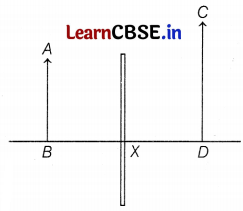
The above diagram shows that two students P and Q experimented on finding the image formation by a mirror. They experimented with different positions of objects and obtained different positions of images. AB, CD, and X represent objects, images, and the optical device respectively.
(a) Based on the text and data given in the above paragraph, identify the type of optical device X.
(b) What will be the position of the image? If the object is placed between the focus and center of curvature.
(c) If the object is placed at a distance of 10 cm in front of the mirror X, then what will be the distance of the image formed? [Take, magnification = -3]
Or
What will happen, if the upper half of the concave mirror ‘X’ is covered?
Answer:
(a) In this case, the image formed is virtual, erect, and magnified. The image is formed behind the optical device X. Hence, device X is a concave mirror. When the object is placed between the pole and the focus of a concave mirror, the image formed will be virtual, erect, magnified, and behind the mirror. (1)
(b) Concave mirror X will form the magnified image of the object as the object is placed between the focus and centre of curvature of the mirror. (1)
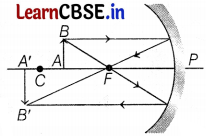
(c) Given, object distance, u = -10 cm
Magnification, m = -3
Now, m = \(-\frac{v}{u}\)
⇒ -3 = \(-\frac{v}{(-10)}\)
⇒ v = -30 cm
The negative sign shows that the image is real and in front of the mirror. (2)
Or
If the upper half of the concave mirror is covered, the focal length of the mirror and object distance do not change, then the brightness of the image will be reduced. (1)
This is because the whole image will be formed by the rays passing through the upper half portion but the intensity of the image formed is proportional to the number of rays and hence the image will be less brighter. (1)